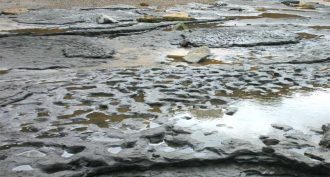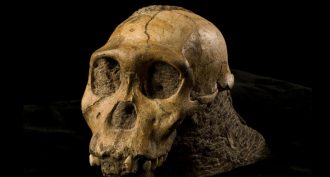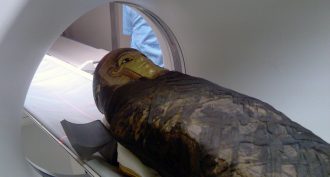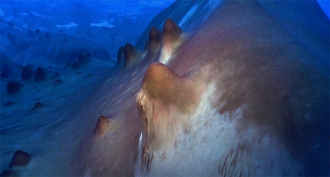MS-LS4-1
Analyze and interpret data for patterns in the fossil record that document the existence, diversity, extinction, and change of life forms throughout the history of life on Earth under the assumption that natural laws operate today as in the past.
-
 Archaeology
ArchaeologyAncient footprints surface in Britain
There are hints they could have been made by ancestors of Neandertals.
By Bruce Bower -
 Fossils
FossilsWhere do humans come from?
Some scientists propose a newfound South African species as the most likely ancestor of the line that led to humans. But not everyone accepts that this is where it all began.
By Bruce Bower -
 Animals
AnimalsThe secret songs of giant beavers
Scientists discover a noisemaking chamber in the extinct animal’s skull.
-
 Fossils
FossilsDino teeth tell a traveling tale
Dental evidence from sauropods suggests the mighty beasts migrated for food.
-
 Humans
HumansMummies share their secrets
Cutting-edge technology such as CT, or CAT, scans and endoscopes are allowing scientists to see not just what’s underneath the wrappings but also what’s inside a mummy’s body.
-
 Humans
HumansOld bones ignite fresh debate
Scientists try to understand how 2 million-year-old fossils fit among ancient species.
-
 Animals
AnimalsWhen the giant ants went marching
A new study of an ancient fossil suggests that 50 million years ago, supersized ants went on a cross-continental trek.
-
 Environment
EnvironmentBusy bacteria leave big mark
Earth’s earliest life-forms built mounds on an Antarctic lake bottom.
-
 Fossils
FossilsDino Flesh from Fossil Bone
Scientists may have found dinosaur blood vessels and cells inside a fossilized leg bone.
By Emily Sohn -
 Fossils
FossilsBig fish in ancient waters
Fossils have revealed an ancient, oversized relative of modern-day swordfish.
By Emily Sohn -
 Fossils
FossilsDino bite leaves a tooth
Meat-eating dinosaurs sometimes feasted on flying reptiles.
By Emily Sohn -
 Fossils
FossilsAncient critter caught shedding Its skin
A fossil reveals that ancient animals shed their skin, just as insects and crustaceans do today.
By Emily Sohn